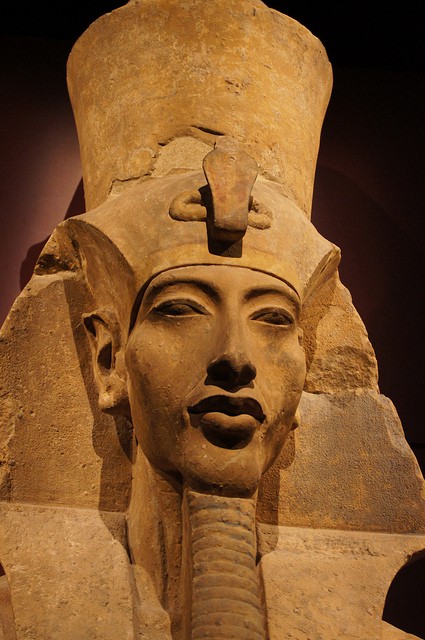“At daybreak, when thou arisest on the horizon,
When thou shinest as the Aton by day,
Thou drivest away the darkness and givest thy rays.
The Two Lands are in festivity every day,
Awake and standing upon their feet,
For thou hast raised them up.
Washing their bodies, taking their clothing,
Their arms are raised in praise at thy appearance.
All the world, they do their work.”
–Akhenaten and the Hymn to the Sun
Akhenaten was an Egyptian Pharaoh who ruled during the 18th dynasty around 1300 BC, along with his wife Nefertiti. Akhenaten was most well-known for his rejection of the highly polytheistic religion and culture of Egypt, and introducing monotheistic worship of a single god.
Origins
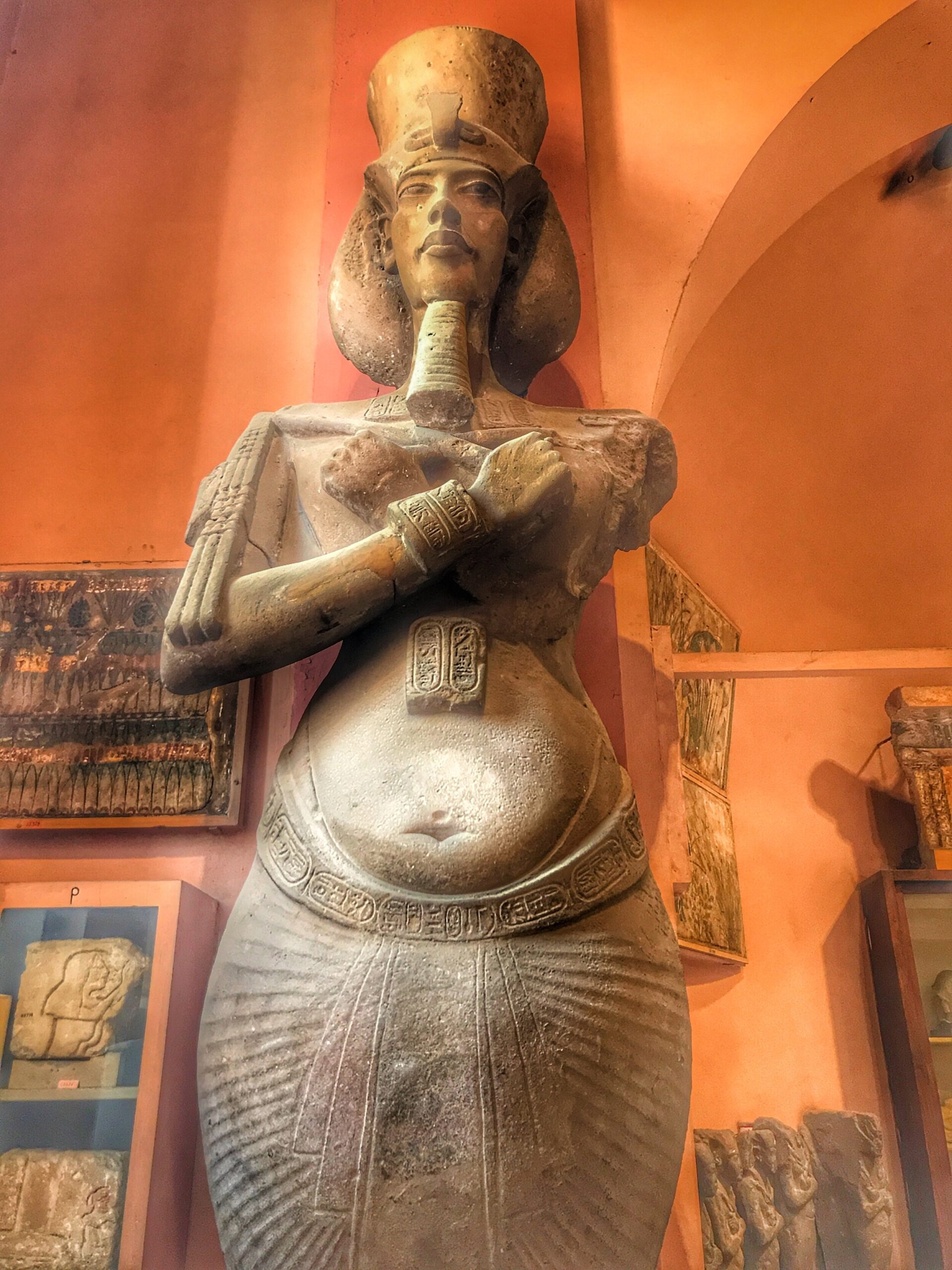
“Akhnaton, Pharaoh of Egypt, throned under the title Amen-Hotep IV, is often referred to as the first civilized human being. While this may not be literally true, he was definitely the first man in recorded history to exemplify social consciousness in the administration of a great nation.
Akhnaton, the beloved child of the Aton, was born at Thebes about 1388 B.C. Like most of the princes of his house, he was extremely delicate as a child, and it was feared that he would not live to reach the throne; as the last of his line, the dynasty would end with him if he died without issue. For this reason he was married in his twelfth year to a ten year old Egyptian girl of noble birth, named Nefertiti.
During the childhood of the young king, the Queen mother, Tiy, ruled as regent of the double empire. She is believed to have been of Syrian origin, which would account for the many strange and un-Egyptian ideas in religion, government and art which were developed during the reign of Akhnaton. Queen Tiy, brilliant and capable, had recognized before her son reached his majority that in him were qualities more divine than human. The son became the actual ruler of his country in his eighteenth year; his reign extended for seventeen years.”
-Manly P. Hall, The Secret Destiny of America
Monotheism
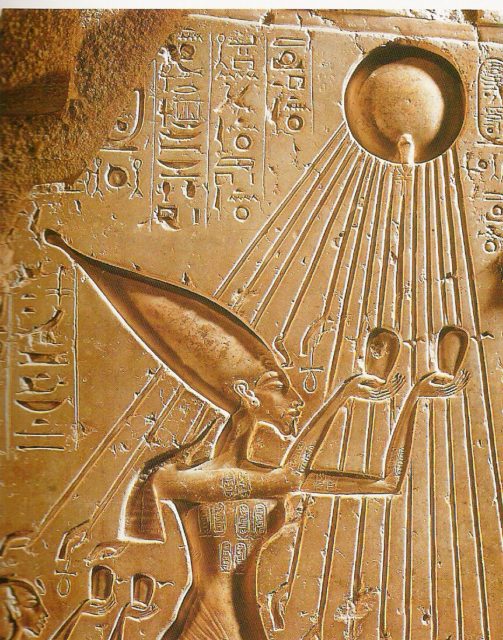
Akhenaten decreed that the only god was the solar god Aten, represented as a Sun disk, and he eliminated all worship and rituals related to the old gods. Eventually he indicated that Aten was beyond the status of even a god.
From a gnostic perspective this is understood as the Agnostos Theos, the unnamed divinity, that which is beyond creation.
Akhenaten and Nefertiti’s reign proved to be unpopular because in their single minded search for spiritual purity they neglected the care and rulership of their people. Little is known about Akhenaten because after his death his statues and monuments were destroyed and the old polytheistic gods reinstated.
As religious monotheism starts to degenerate it leads to anthropomorphism, personifying the one god into having human characteristics. This in turn becomes atheism, rejection of divinity.
“Monotheism always leads to anthropomorphism (idolatry), which by reaction originates materialistic atheism. This is why we prefer polytheism. We are not afraid to talk about the intelligent principles of the mechanical phenomena of nature, even if people classify us as pagans.
We are partisans of a modern polytheism founded on Psychotronics. In the final synthesis, monotheistic doctrines lead to idolatry. It is preferable to talk about intelligent principles, which never leads to materialism. In turn, the abuse of polytheism, by reaction, leads to monotheism.
Modern monotheism emerged from the abuse of polytheism. In this era of Aquarius, in this new phase of the revolution of the dialectic, polytheism must be psychologically and transcendentally sketched out. Besides, it must be put forward intelligently; we must set forth wisely with a vital and integral monistic polytheism. Monistic polytheism is the synthesis of polytheism and monotheism. Diversity is unity.”
–Samael Aun Weor, Revolution of the Dialectic
“Akhnaton had been ruler of Egypt only about two years when he opposed his will to the priesthood of Amon-Ra. By attacking the oldest and most firmly established of all Egyptian institutions, the young Pharaoh created legions of enemies and brought down upon himself the wrath of the religion of the State. He could scarcely have chosen a surer way of complicating the problems of his life.
In the midst of this conflict he proclaimed a new spiritual dispensation, and to escape his enemies built a new capitol city, one hundred and sixty miles up the Nile from Cairo. His new faith was Atonism; and he named his city Khut-en-Aton–the Horizon of the Aton–and dedicated the city with these words: “Ye behold the City of the Horizon of Aton, which the Aton has desired me to make for Him as a monument, in the great name of My Majesty forever. For it was Aton, my Father, that brought me to this City of the Horizon.”
As High Priest of his new religion, Amen-Hotep IV changed his name to Akhnaton, because the older name included the word Amen, whose faith he had rejected.
Charles F. Potter, in his History of Religion, says of Akhnaton that he was, “the first pacifist, the first realist, the first monotheist, the first democrat, the first heretic, the first humanitarian, the first internationalist, and the first person known to attempt to found a religion. He was born out of due time, several thousand years too soon.”
-Manly P. Hall, The Secret Destiny of America
Akhenaten and Nefertiti
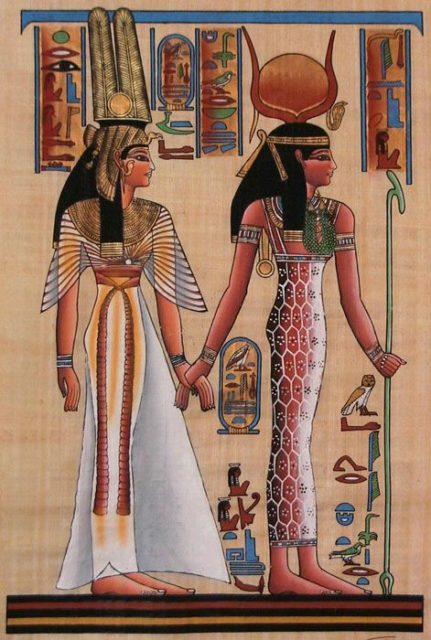
As pharaoh and queen, Akhenaten and Nefertiti were unusual in several respects. Nefertiti was shown beside her king more often than many other queens, indicating that she had a more visible or active part in the rulership.
This famous sculpture of Nefertiti from 3000 years ago is astonishingly modern in style.
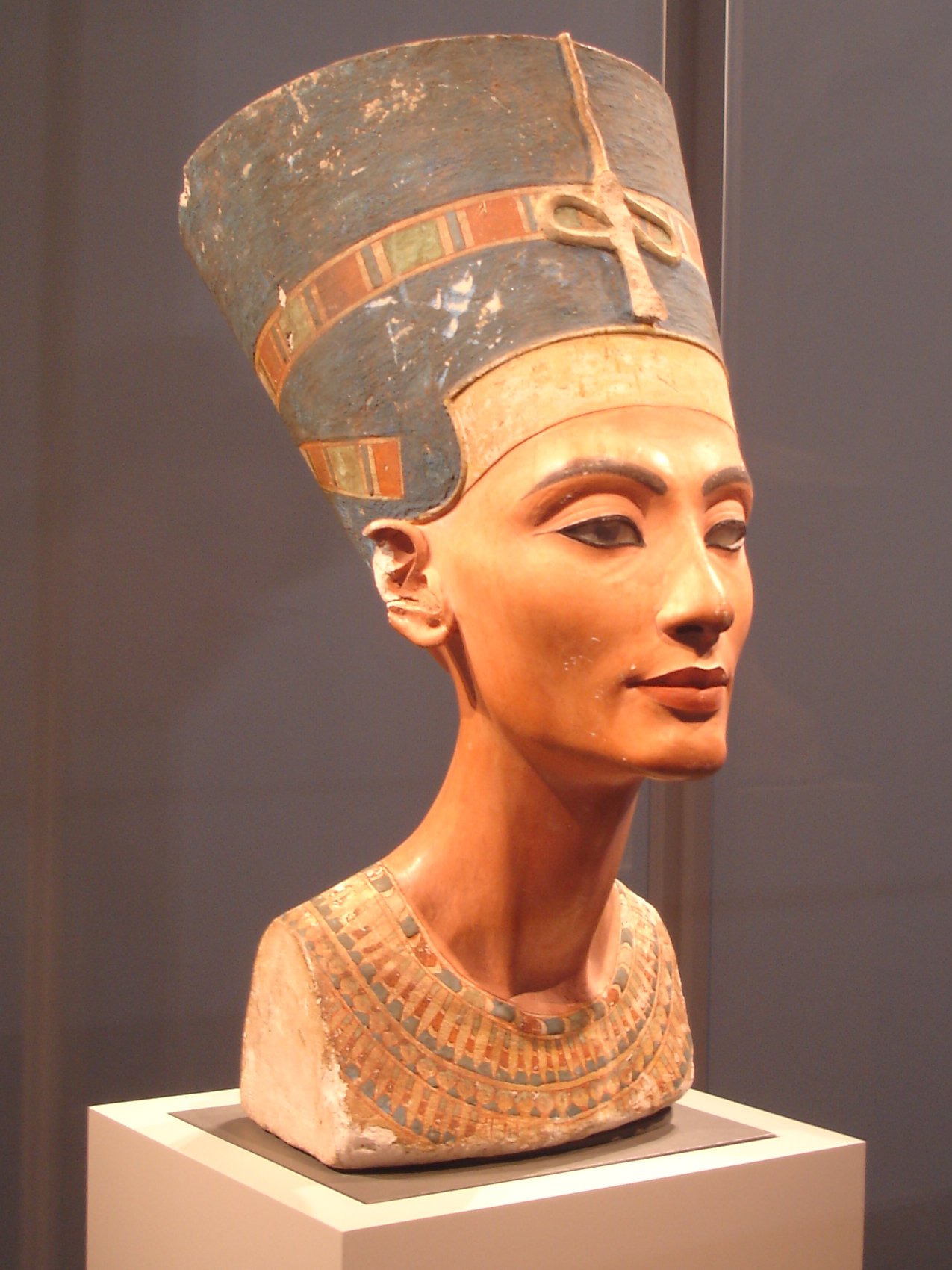
Akhenaten is depicted in statues with an elongated face and skull, and feminine features such as a round belly and wide hips. This is a mystery, but could be esoterically related to having achieved spiritual union through sexual alchemy.
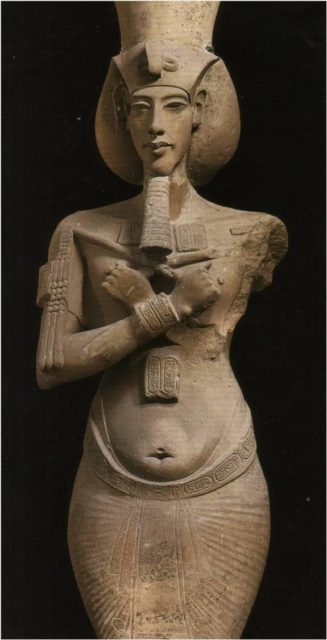
The overall impression of this couple and their reign is that they were visionaries far ahead of their time, and paid a high price for upsetting the status quo.
Akhenaten was also the father of the famous Tutankhamun, who was responsible during his reign for reversing the exclusive worship of Aten.
The remains of Tutankhamun or “King Tut”, in his mummy form, tours the world by way of museums and universities. In this way, part of the work of King Tut in his afterlife is teaching people about the mysteries of ancient Egypt.
“Like most of the great religious leaders, Akhnaton accepted the social problem of life as part of religion. He could not accept the inequalities of birth, wealth, or physical estate as a justification for men persecuting each other or exploiting one another. He saw every living thing having a divine right–a right to live well, to think, to dream, to hope, and to aspire. He saw it the duty of the ruler to protect this beauty in the hearts of his people, to nourish it, and to give every possible opportunity for its expression and perfection.
Religious intolerance was impossible among those who worshipped the Atan, and there was no room for political intolerance in a world governed by the laws of brotherly love. Each man became the protector and comforter of all other men, cherishing the dreams of others equally with his own.
In his personal life Akhnaton emerges as the first man in history to bring dignity and gentle beauty to the management of his home. He was the father of seven daughters, to whom he was completely devoted, and in his speeches and public pronouncements he always referred to Queen Nefertiti as “my beloved wife.”
It was usual for the Pharaohs to cause themselves to be depicted in great stone carvings upon the walls of their palaces. They were represented as majestic figures, crowned and sceptered; they were shown either seated on their thrones or wielding their weapons against their foes. Akhnaton was the only Pharaoh in the history of Egypt who chose to be depicted with his arm about his wife, with his little daughters playing about and seated on his lap.”
-Manly P. Hall, The Secret Destiny of America
Ahkenaten and Moses
According to Sigmund Freud in his book Moses and Monotheism, the life story and timeline of the biblical Moses and Ahkenaten are significantly intertwined. Although this book is more a psychological thought experiment than true history, the parallels are interesting, even from just an allegorical perspective.
Moses was raised in Egypt in the house of the Pharaoh, eventually becoming a high ranking member of the court. He liberated the Hebrews from Egyptian slavery and lead them through a long exodus.
The monotheistic religion of Ahkenaten was so radically different from the Egyptian religion that it is possible it could have been related to the revelation of the leader of the Hebrews.
Legacy
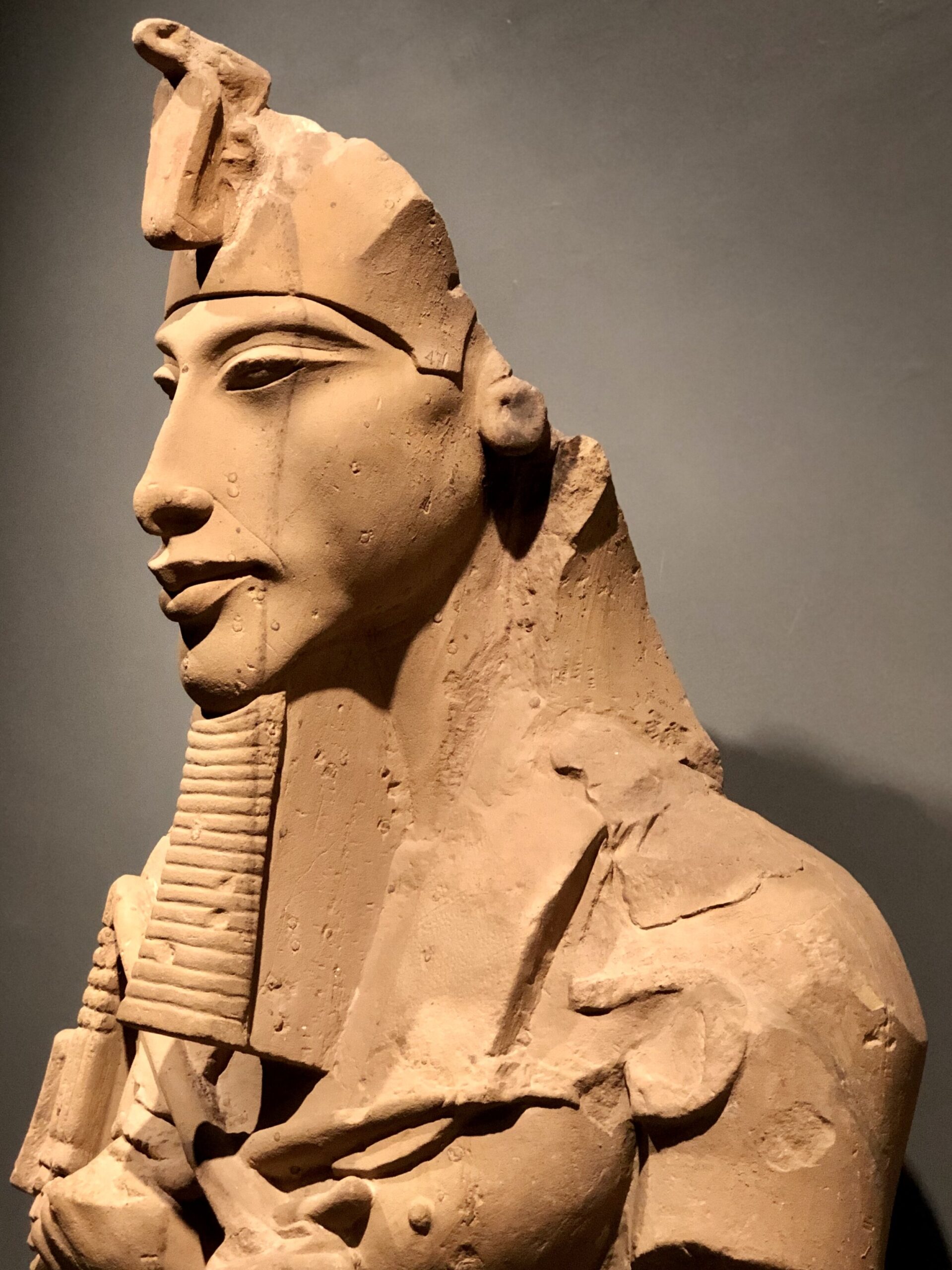
“As with the passing years the health of the Pharaoh grew worse, the opposition of the priesthood of Amon-Ra grew greater; and his reign was complicated by invasions by the Hittite nations. The governors of various provinces pleaded with him for help, but Akhnaton would not send armies.
The dreamer king saw his lands pillaged and his cities conquered; but he would not kill his enemies; they, too, were children of the Aton.
Akhnaton died in his thirty-sixth year, at the altar of the Aton in the temple of the faith he had created. When his mummy case was found, the following prayer to the Aton was discovered inscribed on golden foil beneath his feet. “I breathe the sweet breath which comes forth from Thy mouth. I behold Thy beauty every day …. Give me Thy hands, holding Thy spirit, that I may receive it and may be lifted by it. Call Thou upon my name unto eternity, and it shall never fail.”
In the words of the great Egyptologist, Professor Breasted, “There died with him such a spirit as the world had never seen before.”
Akhnaton was the first man in history who dared to dream of the Brotherhood of Men, and he cheerfully gave his life and his empire for that dream.
He is indeed, “The beautiful child of the Living Aton, whose name shall live forever and ever.””
-Manly P. Hall, The Secret Destiny of America
Ahknaten Opera
The composer Phillip Glass wrote an opera on the life of Ahkenaten, stylizing it Akhnaten, in 1983. This modern masterpiece tells the life story of Ahkenaten with powerful music and lyrics in the ancient Egyptian language. Sources for the narration and dialogue include the Egyptian Book of the Dead, a poem by Akhenaten himself, and Freud’s book Moses and Monotheism.
Act 1
The opera begins with the funeral of Akhnaten’s father, and his subsequent coronation as ruler of Upper and Lower Egypt. Akhnaten announces his intention to bring in a new monothiestic religion to Egypt.
Act 2
Akhnaten banishes the priests from the temple when they continue the old rituals and worship of the many old Egyptian gods. He chooses the site of a new city, to be called Akhetaten “The City of the Horizon of Aten”, and sings a prayer to Aten.
Act 3
Akhnaten and Nefertiti and their family become more isolated within their palace and their own religion. Eventually the priests and the unhappy people of Egypt revolt. They break into the palace, separate the family, and kill Akhnaten. The final scene shows what little is left of the temple and city in modern day Egypt, while the ghosts of Akhnaten and Nefertiti wander the ruins.

